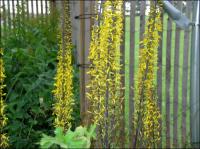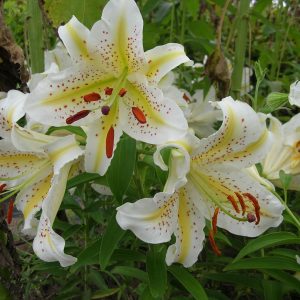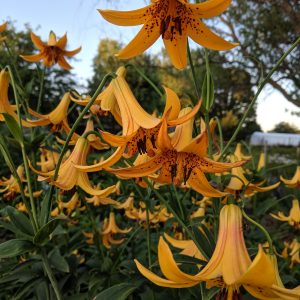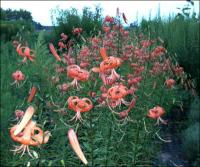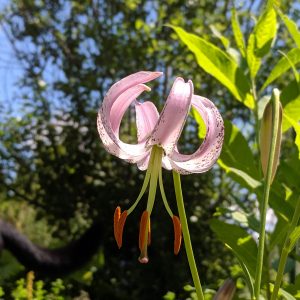Shop
Showing 465–472 of 788 results
-
Ligularia japonica syn. Ligularia kaempferi syn. Farfugium japonicum Leopard plant
Cutleaf bold foliage, golden yellow-orange daisy-like flowers in late summer
OUT OF STOCK
Cutleaf bold foliage, golden yellow-orange daisy-like flowers in late summer
Size: 4’ x 12”
Care: part shade in moist, fertile soil
Native: Japan, China & KoreaCollected and grown in the West before 1841. July 6 1872 The Garden reported that it bloomed in London.
-
Ligularia przewalskii syn. Senecio przewalskii Leopard plant Z 4-8
Bold, deeply palmate lobed foliage, deep yellow spike in late summer
Bold, deeply palmate lobed foliage, deep yellow spike in late summer
Size: 5-6' x 24-36"
Care: full to part shade in moist soil.
Native: Northern ChinaNamed for Nikolai Przewalski (1839-1888), Polish geographer and naturalist who explored Central Asia on behalf of Russia. First described in Bulletin de l’Academie Imperiale des Sciences de St-Petersburg, sér. 3 26(3): 493. 1880.
-
Ligularia siberica Z. 3-8
Spikes of yellow daisies atop a clump of bold, round leaves from June to August
OUT OF STOCK
Spikes of yellow daisies atop a clump of bold, round leaves from June to August
Size: 3-4' x 2’
Care: sun to shade in moist soil
Native: from France to JapanThis species in gardens before 1750. It was the 1st species of the genus, named by Linnaeus in 1753. Father of perennial borders, William Robinson: “Fine leaved and worth growing.” L.H. Bailey: “Said to be a showy marsh plant.”
-
Ligularia stenocephala Leopard plant Z 4-8
Daisy-shaped buttercup to golden yellow flowers cover narrow, 4-5 ‘tall spikes from late summer to early fall. Its foliage is as arresting as the flowers. Big, rounded-triangular shaped leaves with sharply scissored edges surround the bottom with smaller ones cover the stems until the leaves meet the bottoms of the flower spike.
Daisy-shaped buttercup to golden yellow flowers cover narrow, 4-5 ‘tall spikes from late summer to early fall. Its foliage is as arresting as the flowers. Big, rounded-triangular shaped leaves with sharply scissored edges surround the bottom with smaller ones cover the stems until the leaves meet the bottoms of the flower spike.
Size: 5’ x 5’
Care: part shade in moist soil
Native: China, Taiwan, and Japan
Wildlife Value: a favorite nectar and pollen source for bees and butterflies. Rabbit resistantCollected and first named by Russian botanist Carl Johann Maximowicz (1827 – 1891). St. Peterburg Botanic Garden sent him to South America where he searched for plants around Rio, then crossing Cape Horn he collected in Hawaii. After his ship was commandeered off the coast of China, he crossed China from west to east through China and Siberia recording his specimens that grew along the Amur River. He returned traveling west to east then crossed the East China Sea of the Pacific Ocean to Japan where he collected for four years.
-
Lilium auratum Gold-band lily, Yamayuri in Japan Z 5-8
Very fragrant, recurved white trumpets with gold bands radiating from the center down the middle of each petal, decorated with red spots. Blooms in late summer.
Very fragrant, recurved white trumpets with gold bands radiating from the center down the middle of each petal, decorated with red spots. Blooms in late summer.
Size: 3-4’ x 12”
Care: Plant 3-4 times deeper than the bulb’s height, i.e. if bulb is 2’ tall plant the bottom of the bulb 4” deep. Sun to part shade in well-drained soil, slightly acidic. Mulch.
Native: Japan in forest edges in mountains north of south-central Honshu Island.
Awards: Royal Horticultural Society Award of Garden MeritLilium was named for the Greek word for smooth, polished referring to its leaves. The Chinese cultivated this lily since 1688. Japanese cultivated this bulb as a vegetable: “I have eaten them pretty often, and rather relished them, as they are, when cooked, sweet, mucilaginous, and without any decided taste to make them objectionable to a newcomer.” American Gardener, May 1882. English nurseryman John Veitch introduced this lily to Europe in 1861. Considered “queen of the lilies” in late Victorian gardens. The Wisconsin Horticultural Society described it as the “most beautiful of all Japan lilies…” (1896).
-
Lilium canadense, Z 2-6
Showy, drooping bell-shaped flowers from lemon to dark orange in color with conspicuous red spots on the inside
OUT OF STOCK
Showy, drooping flowers from lemon to dark orange in color with conspicuous red spots on the inside.
Size: 2-4’ x 6”
Care: part shade in moist to moist well-drained, slightly acidic soil
Native: Upper Great Lakes & southern Canada
Wildlife Value: attracts butterfliesIntroduced to gardens from its native North America by Jacques Cartier, 1535. Also collected by Swedish botanist Pehr Kalm (1716-1779) who collected in Northeastern US and SE Canada and sent it to Linnaeus. Grown at America’s 1st botanic garden, Elgin Botanic Garden 1811. Listed in the 1873 catalog of Leichtlin’schen Gartens in Baden-Baden.
-
Lilium lancifolium Tiger lily, in Japan called “oniyuri” Z 2-7
Late summer, orange, recurved blossoms with black spots
Late summer, orange, recurved blossoms with black spots
Can not ship to: Delaware and Maryland.
Size: 3-4' x 12"
Care: Sun to part shade in any soil
Native: AsiaLilium was named for the Greek word for smooth, polished referring to its leaves. The Tiger lily was in Chinese literature as long ago as the 10th century. The Chinese grew it in rows as a vegetable and wrote it brought the pained dragon to life. First described for the West by Englebert Kaempfer, physician to Dutch East India Co. on Deschema Island in the 1690’s. William Kerr sent the Tiger lily from Canton China to Kew in England in 1804. First Asian lily imported to America. A Tiger lily grew in Wonderland’s looking glass garden where it told Alice “We can talk…when there is anybody worth talking to.”
-
Lilium lankongense pu jing bai he in China Z 5-8
In June to July 6 to 12 fragrant, pale pink upturned petals with deep red spots blossom on this elegant lily.
ARCHIVED
Note: This is a plant not currently for sale. This is an archive page preserved for informational use.
In June to July 6 to 12 fragrant, pale pink upturned petals with deep red spots blossom on this elegant lily.
Size: 25-36” x 12"
Care: sun in well-drained to moist well-drained soil, acidic soil
Native: alpine grasslands in Xizand and Yunnan ChinaCollected before 1892.


